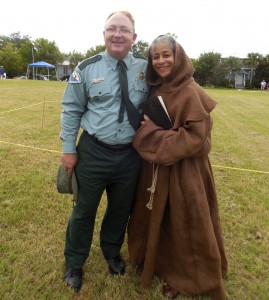Submitted by Suanne Z. Thamm
Reporter – News Analyst
The sleepy little Fernandina Beach neighborhood known as Old Town was transformed into a beehive of activities on Saturday, September 28, 2013, as city residents, cultural organizations and visitors celebrated the rich Spanish heritage of the state and the city in a celebration called Viva Florida! as part of Viva Florida 500, a state-wide initiative to commemorate Ponce de Leon’s arrival, and to celebrate the last 500 years of people, culture, and achievements in the state of Florida.
In his book Florida: A Short History, prominent Florida historian Michael Gannon reminds his readers that Florida has the longest recorded history of any of the American states. He adds that by the time the Pilgrims came ashore at Plymouth, St. Augustine was up for urban renewal. Indeed, Florida was ruled by Spain for 234 years: from 1565 to 1763, and then again from 1783 to 1819, when it became an American territory. As both a territory (1819) and eventually a state (1845), the United States has yet to equal the longevity of the Spanish in ruling this land.

Yet it is difficult for today’s city residents and visitors to understand the importance of Spain to the development of Fernandina, because unlike St. Augustine, little remains today reflecting the Spanish presence and influence. The Amelia Island Museum of History, Fort Clinch State Park, the city of Fernandina Beach and Old Town activists set out to remedy that situation with a weekend of programs, tours, and other activities set in Old Town, the last Spanish-platted city in the Western Hemisphere.

Saturday’s activities centered on the Old Town Plaza, site of the former parade ground for the Spanish military. The original fort, situated on the far western edge of the plaza, no longer exists due to erosion. The plaza is today owned and maintained by Fort Clinch. One of the exhibits that drew curious visitors was a demonstration of ground penetrating radar under the direction of Professor Gordon Rakita, University of North Florida. This is the most recent of several archaeological studies for the Old Town settlement that date back into the 1950’s.

Another highlight of Saturday’s activities was the recreation of a Spanish peonia (land measure platted by the Spanish for building lots), complete with the façade of an old Spanish home and a petting zoo, composed of the type of domestic animals that would have been raised by early residents.

Since Fernandina under Spanish rule was quite a ways from the stronghold of St. Augustine, certain lawlessness prevailed here. Modern day pirates strolled Old Town Saturday, as a reminder that real pirates at one time plied their trade in waters off the Florida coast.
Fernandina’s history is even more complicated than general Florida history because of its border status to the United States and its profitable role in both smuggling and slave trading after the 1808 Embargo Act. As many people know, locals refer to Amelia Island as the “Isle of 8 Flags.” Three of those flags flew during the Second Spanish Period (1783-1819) when three separate attempts to oust Spain from Fernandina briefly succeeded.

In an attempt to boil down a very complicated history for the enrichment and enjoyment of Viva Florida visitors, Old Town resident and Museum Board Member Jennifer Harrison authored a play, which premiered on the Plaza Saturday morning. Many Museum volunteers took on roles of ordinary citizens and history makers as they paraded across the stage to tell the stories of the many people who settled Fernandina and influenced its development until it became what it is today. Amelia Hart directed this play, which was a fleeting but fitting overview of the island’s rich history.

Afternoon events included Bluegrass music, Flamenco dance, food and tours of Old Town.
An important part of the day’s activities was the Middle Passage Ceremony (Click here for more information.)to honor the countless Africans who lost their lives being brought across the Atlantic to be sold into slavery. An estimated 15% of those who were forced to make the journey to the New World died in the crossing. The ceremony included the Peck Community Ensemble, along with Queen Quet of the Gullah Geechee Nation. Neil Frink and Gwen Triay, both of whom have long standing ties to Old Town and the Fernandina community.

Fernandina’s celebration of Viva Florida 500 will continue in October, as the Amelia Island Museum of History presents Talking Dirt: The Many Voices of Florida Archaeology – a series of three, one hour lectures on archaeology and Florida history. The series kicks off on October 12th, with a presentation entitled Exploring Ancient Florida by Dr. Rachel Wentz, followed on October 19th with a lecture on Native American Medicinal Plants by Dr. Michelle Williams, and concluding with Sarah Miller presenting Grit Tempered II: Famous Women in Florida Archaeology, on October 26th. The series will be held at the Peck Center, in the Willie Mae Ashley Auditorium. Consult the Amelia Island Museum of History’s website www.ameliamusuem.org for further details.
Editor’s Note: Suanne Z. Thamm is a native of Chautauqua County, NY, who moved to Fernandina Beach from Alexandria,VA, in 1994. As a long time city resident and city watcher, she provides interesting insight into the many issues that impact our city. We are grateful for Suanne’s many contributions to the Fernandina Observer.
September 30, 2013 1:15 p.m.

